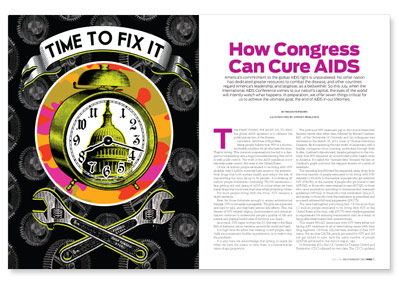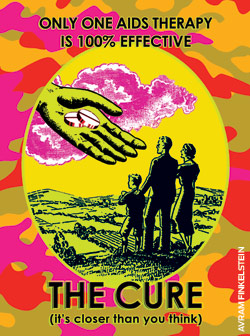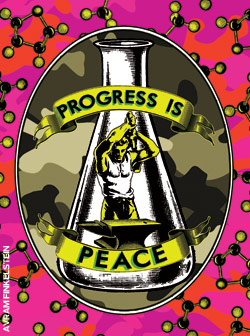
The first thing we must do to end the global AIDS epidemic is to reframe the public perception of the disease.
Let’s face it. AIDS has a PR problem.
Many people believe that HIV is a chronic, survivable condition for all who have the virus. They’re wrong. This common misperception has led to a dangerous complacency and a huge misunderstanding that AIDS is well under control. The truth is the AIDS pandemic is not remotely under control. Not even in the United States.
Of the 34 million people estimated to be living with HIV globally, only 6 million currently have access to the antiretroviral drugs that both sustain health and reduce the risk of transmitting the virus by up to 96 percent. A horrifying 28 million people worldwide—including 750,000 Americans—face getting sick and dying of AIDS in a time when we have many drugs that could save their lives while protecting others.
For most people living with the virus, HIV remains a death sentence.
Even for those fortunate enough to access antiretroviral therapy, HIV is not easily manageable. The pills are expensive and hard to take, and they have serious side effects. Plus, the threats of HIV-related stigma, discrimination and criminalization continue to undermine people’s quality of life and mental and physical health even if the virus is in check.
As a result, HIV rages on from the DC Beltway to the Black Belt of Alabama, across America, around the world and back.
It is high time we admit that treating so few people, especially since treatment doubles as prevention, is no way to stop the pandemic.
It is also time we acknowledge that letting so many die when we have the means to save them is a humanitarian crime of epic proportion.
The profound HIV treatment gap in the United States first became crystal clear when data collected by Edward Gardner, MD, of the University of Colorado and his colleagues was reviewed in the March 15, 2011, issue of Clinical Infectious Diseases. By documenting the vast swath of Americans with a deadly, contagious virus coursing unchecked through their bodies, Gardner’s data showed, despite perception to the contrary, that HIV remained an uncontrolled public health crisis in America. It’s called the “cascade data” because the line on Gardner’s graph mirrored the stepped descent of a series of waterfalls.
The cascading line followed the sequential, steep drops from the total number of people estimated to be living with HIV stateside (1,106,400), to the number of people who got tested for HIV (874,056), to the number of people who got linked to care (655,542), to those who were retained in care (437,028), to those who need medication according to recommended treatment guidelines (349,622), to those who took medication (262,217), and finally, to those who took the medication as prescribed and as a result achieved full viral suppression (209,773).
The data highlighted a shocking fact: Of the more than 1.1 million people estimated to be living with HIV in the United States at the time, only 209,773 were virally suppressed (a requirement for reducing transmission risk) as a result of being effectively treated with antiretrovirals. This meant 896,627 Americans with HIV were either not taking ARV treatment at all or were having issues with their drug regimens. Of those, 232,344 were unaware of their HIV status. But another 218,514 people got tested for HIV and did not get linked to care. And the same number of people (218,514) got linked to, but did not stay in, care.
This meant 896,627 Americans with HIV were either not taking ARV treatment at all or were having issues with their drug regimens. Of those, 232,344 were unaware of their HIV status. But another 218,514 people got tested for HIV and did not get linked to care. And the same number of people (218,514) got linked to, but did not stay in, care.
In November 2011, the U.S. Centers for Disease Control and Prevention (CDC) released its own data. The CDC’s updated math looked slightly different from Gardner’s, but not much rosier. According to the CDC, of the 1.2 million people estimated to be living with HIV in America, about 750,000 were not accessing treatment. (Some portion of these people did not know they had HIV. But most did.)
It’s understandable that those who don’t know they have HIV wouldn’t seek help. But why would nearly half a million people in the United States who are aware they are living with a potentially deadly disease not connect to or return to a doctor? Especially when a doctor could give them drugs to save their lives?
In a word, disparity. Economic and social disparity linked to skin color. HIV disproportionately impacts people of color, people who are more likely to have a history of poverty, rural residence, substance use, depression, homelessness, mental health issues and incarceration. In addition, people of color have often have limited access to the services they need to link them to the medical care they require. And deserve.
Nearly half of all new cases of HIV in America are among men who have sex with men (MSM). So as important as it is to address the racism that can lead to HIV, it is equally important to combat the homophobia that fuels HIV and prevents MSM of all races from feeling comfortable coming forward to get tested and treated for HIV.
The disease also disproportionately impacts women, especially women of color. African-American women are 20 times more likely to contract HIV than white women. And HIV is the leading cause of death for black women ages 15–44 worldwide.
In short, the second thing we must do to stop AIDS is to address the underlying drivers of the pandemic such as racism, homophobia, sexism and xenophobia.
But while inequities based on race, gender and sexual orientation perpetuate the spread of AIDS, there are also logistical, emotional and lifestyle barriers to connecting people with HIV with care.
Which is why the third thing we must do to end AIDS is to formally research and actively address barriers to entry to—and retention in—clinical care.
Several well-designed studies conducted by the pharmaceutical industry along with public and private research networks have identified successful ways to improve adherence to drug regimens, such as directly observed therapy, electronic pill bottle caps, text and phone reminders, educational programming and a variety of counseling methods. We know what works to help people take their pills as prescribed.
By comparison, there is an astounding dearth of data identifying optimal ways to address barriers to care. We need a global tool kit of best practices.
America has underwritten programs abroad that have successfully treated people with HIV in places some thought it impossible to do so. Perhaps it’s time to consider applying some of the lessons and best practices we learned fighting AIDS in the Global South to help us better fight AIDS in America. If we can see incidence decline sharply in developing nations with a lack of infrastructure, clean water and food; with challenging physical environments (like virtually impenetrable rural terrain or extremely violent urban settings); with unstable or young governments; and with low general and health literacy, we should not have a flatlined rate of HIV incidence in the United States. If we can beat down AIDS in places like Soweto, rural Kenya and communist Vietnam, we should be able to do it in Alabama, Detroit and Washington, DC—places where the percentages of people living with HIV rival those of developing nations.
It’s key to note that some people with HIV need time after being diagnosed to emotionally or logistically prepare to start treatment. Some are diagnosed before they qualify for being eligible for medicine. Some choose not to take it.
But the truth remains that at one point, nearly all of the 750,000 untreated Americans and 28 million people globally will require care. We should have a clear vision for how to help them overcome barriers to it, and we should be prepared to implement that vision as quickly as possible.
The fourth thing we must do to end AIDS is to make treatment more affordable. As access to care for many people around the world is dependent on their nations’ ability to purchase the drugs, price remains a huge factor.
In an era when many states and national governments cannot afford to buy more drugs for those in need, the drug manufacturers continue to raise their prices. Despite a growing global need, the drug manufacturers defend the perimeter of their remaining patents. There is great pressure to prevent Indian-manufactured generics from entering nations in the European Union, and similar battles are being waged in the Pacific Rim.
Let’s be clear. The reason treatment for HIV/AIDS remains so expensive is not conspiracy. It’s capitalism.
But while we get that the pharmaceutical industry is a for-profit enterprise, which undoubtedly helps drive ingenuity, many companies have crossed the line between financial growth and bald-faced greed. And when you are a for-profit industry manufacturing products that people require for survival, compassion should at some point be a counterweight for profits.
Bigger contributions from a great number of nations are necessary for the global health funds to get more people in impoverished nations linked to care. But even as systems shift who will pay for the drugs and as more nations consider stepping up to get some skin in the AIDS game, there’s no way around the fact that many people with HIV can’t afford the care they need and therefore rely on others for their survival.
Surely there is a way to reconfigure global drug pricing to make greater volume more profitable to the drug manufacturers.
U.S. Senator Bernie Sanders (I–Vt.) has introduced a bill to make AIDS drugs more affordable. It’s called S. 1138, and it is designed to “de-link research and development incentives from drug prices for new medicines to treat HIV/AIDS and to stimulate greater sharing of scientific knowledge.”
The bill proposes offering a $3 billion annual prize to any medical R&D company that develops affordable HIV/AIDS drugs for America. (The prize replaces patents for the meds.) President Bill Clinton has also broached the topic of making lower-priced AIDS medications available in the United States. What if governments were to offer tax breaks or financial incentives to drug companies to lower prices? Generic meds in the developed world before patents expire? It’s an idea whose time has definitely come.
President Bill Clinton has also broached the topic of making lower-priced AIDS medications available in the United States. What if governments were to offer tax breaks or financial incentives to drug companies to lower prices? Generic meds in the developed world before patents expire? It’s an idea whose time has definitely come.
Even if the drugs are widely accessible and affordable, other factors keep people from knowing their status and seeking treatment. One of the most potent is fear of HIV-specific criminalization. It also deepens the stigma around the disease that in itself is a barrier to testing and treatment.
That’s why the fifth essential thing to do to end AIDS is to decriminalize it.
HIV-specific laws intended to prosecute people with HIV for allegedly intentionally exposing others to the virus are unnecessary because existing laws are sufficient to punish the few people who intend to harm someone by exposing them to HIV.
More and more people with HIV are prosecuted (some have gotten 25-year sentences) for alleged nondisclosure of HIV to a sexual partner—even if protection was used and no transmission occurred. This leads people to fear knowing and disclosing their status. As being in possession of HIV meds can lead others to discover your status, HIV-related criminalization impedes both testing and treatment.
Most people with HIV are not predatory monsters. On the contrary, scientific evidence supports that the majority of people with HIV are responsible people with no intent to harm others.
When people know their HIV status, they are five times less likely to engage in activities that put others at risk. Roughly 50 percent of all new infections (in the United States) originate with the 20 percent of people who don’t know their status. Therefore, people who don’t know their HIV status are four times more likely to transmit the virus.
Testing and treatment are prevention. And since criminalization keeps people from getting tested and treated, criminalization backfires as a means of protecting individual and public health. Conversely, stopping HIV-related criminalization helps lift the stigma around people with HIV.
If we want more people to come forward for testing and treatment, we must make it safe for them to do so. One great way to do that is to encourage congressional support for Representative Barbara Lee’s (D–Calif.) “Repeal HIV Discrimination Act” (H.R. 3053).
Who wants to know their HIV status or take medicine for it if doing so can lead to decades in prison?
Ending AIDS also requires that we get over our prudishness and be willing to talk non-hysterically about sex and injection drug use. We need to do so in our homes, schools, places of worship and society at large. We need to be willing to do so to our children, our parents, our family and our friends.
We must understand and address the things that place people in situations and the mind-sets that lead them to high-risk behavior. When people are oppressed, victimized, impoverished, jobless, homeless, undereducated, overwhelmed, desperate or vulnerable, when they suffer from low self-esteem or find themselves fighting for their basic survival needs, then they are more likely to do things they otherwise might not do—such as using injection drugs or engaging in unsafe sex.
People who become addicted to illicit substances need substitution therapy, sterile injection equipment and other harm reduction strategies. People who sell their bodies for survival need condoms and biomedical prevention options they can afford and administer themselves.
Sterile syringes and condoms are sensible, responsible tools for personal protection and public health. It has been repeatedly proved that access to them does not make people inject more drugs or have more sex. It allows people to inject drugs and have sex without contracting or spreading disease.
Thirty years of trying to change behavior has failed. The sixth thing we must do to end AIDS is to recognize that money spent trying to tell people not to have sex and do drugs would be better spent helping them do those things safely.
Removing barriers to testing and treatment and having a more realistic approach to prevention are all critical. But we shouldn’t stop there. Because a lifetime of treatment cannot be our endgame.
The best way to end AIDS is to cure it.
We must prioritize and spend more money on the hunt for the cure. We must reframe the agenda of AIDS advocacy and put the cure at the top of our asks. Congress has the power to appropriate more funding for AIDS cure research. For that to happen, we must make our legislators aware of the significant scientific breakthroughs that have recently occurred and help them understand that the world’s preeminent virologists believe an AIDS cure is possible.
AIDS has been cured in one person. Though the method of his cure is not widely (or even narrowly) replicable, it served as proof of concept that it can be done and gave scientists many clues about how it might be done more widely.
As a result, AIDS cure research has made quantum leaps forward in the past 24 months. Researchers, many working in newly formed consortiums, are forging down promising avenues.
No one knows exactly what the cure will look like and whether it will be a “functional” one (one that allows the bodies of people with HIV to eventually control the virus without the aid of medicine) or a “sterilizing” one (one that eradicates all traces of HIV from a person). It may involve treatment (including the drugs currently administered) or a therapeutic vaccine or both. What we do know is it’s possible and we’ll get there a lot faster if we secure necessary political and financial capital.
Some experts estimate we could find a cure within our lifetimes with as little as an additional $100 million. I’d bet my bottom dollar that if AIDS were cured, people would find their way over any barrier to get at the cure. Not only would it save lives, a cure would also abolish HIV-related stigma—one of the main barriers to health care for people with HIV/AIDS.
The men and women on Capitol Hill influence the way in which the world responds to the global AIDS fight. Which is why the U.S. Congress needs to be aware of the current science. The science speaks plainly. AIDS is preventable. AIDS is treatable. And it could even be cured in our lifetimes if world leaders act courageously and swiftly.






7 Comments
7 Comments